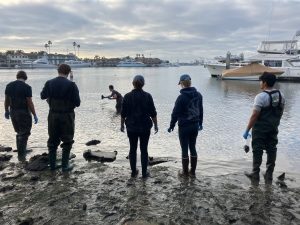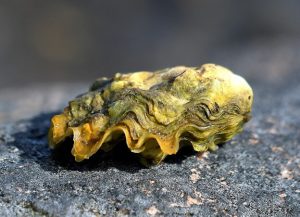Bight ’23 shellfish study to benefit 4 study elements

The 2023 cycle of the Southern California Bight Regional Monitoring Program has launched a year-long investigation to comprehensively track the accumulation of multiple different types of contaminants in shellfish – a highly leveraged effort that will generate insights benefitting four Bight ’23 study elements.
The Bight ’23 shellfish assessment, which kicked off in January, will investigate the degree to which legacy contaminants, PFAS (per- and polyfluoroalkyl substances), toxins produced by harmful algal blooms (HABs), microplastics, and pathogens are accumulating in the tissues of oysters and mussels.
Via this study, four separate Bight ’23 study elements that have traditionally operated mostly in silos – Sediment Quality, HABs, Trash and Microbiology – will work collaboratively to oversee and manage the shellfish assessment, making it a uniquely cross-cutting Bight ’23 investigation.
The shellfish assessment’s kickoff follows the successful completion of field sampling for the Bight ’23 Sediment Quality study element last summer.
Shellfish, which are filter feeders that can inadvertently take up and concentrate contaminants from surrounding water, are a cornerstone of marine food webs. Humans also consume locally harvested shellfish and use shellfish as fishing bait, underscoring the importance of assessing what levels and types of contaminants are accumulating in their tissues.
Field crews are collecting wild oysters and mussels from 30 sites from the Southern California Bight coastal zone that are ecologically important or popular recreational harvesting locations. Samples will be collected during the winter, spring and fall to capture a range of exposure conditions and pathways in the Bight.
The field protocols and selection of monitoring sites are being informed by the California State Mussel Watch Program, which monitored contamination levels in mussels from the 1970s to 2003. Significantly, the Bight ’23 shellfish assessment will compare its data to historical Mussel Watch data. Mussel Watch also is expected to resume monitoring this year in coordination with Bight ’23.
The Bight ’23 shellfish assessment is targeting both oysters and mussels, which can hold contaminants in their tissues for differing amounts of time. Oysters also are a cornerstone species in ongoing efforts to build “living shorelines” across California that help restore and protect vulnerable coastal areas. Mussels, meanwhile, are often used as bait for recreational sportfishing.
Bight ’23 intends to report concentrations of each indicator relative to human health and ecosystem health thresholds that could result in impacts from consumption of shellfish tissues.

The study will also provide regional context benefitting multiple local studies investigating the effects of contamination on shellfish in the Bight, including an ongoing monthly HAB toxin shellfish survey overseen by the Los Angeles Regional Water Quality Control Board, a shellfish contaminant assessment in San Diego County, and an ongoing study examining the appropriateness of an existing California water-quality standard designed to protect the health of people who consume shellfish.
The shellfish study represents the Bight program’s bioaccumulation study for Bight ’23. Since 1998, the Bight program has conducted bioaccumulation studies as a line of evidence supporting the overall contaminant impact narrative for the Sediment Quality study element. Previous bioaccumulation studies have focused on sportfish and bird eggs.
Bioaccumulation is the process by which contamination in sediment and the water column passes through marine food webs from prey to predator, eventually reaching humans.
For more information, contact Dr. Karen McLaughlin or Dr. Jayme Smith.
More news related to: Emerging Contaminants, Eutrophication, Harmful Algal Blooms, Regional Monitoring, Sediment Quality, Southern California Bight Regional Monitoring Program, Top News, Trash Pollution